Henry Moreland Stanley, the American, almost immediately succeeded the Englishman, Cameron, on the road of discoveries. We know that this intrepid correspondent of the New York Herald, sent in search of Livingstone, had found him on October 30th, 1871, at Oujiji, on Lake Tanganyika. Having so happily accomplished his object for the sake of humanity, Stanley determined to pursue his journey in the interest of geographical science. His object then was to gain a complete knowledge of Loualaba, of which he had only had a glimpse.
Cameron was then lost in the provinces of Central Africa, when, in November, 1874, Stanley quitted Bagamoga, on the eastern coast. Twenty-one months after, August 24th, 1876, he abandoned Oujiji, which was decimated by an epidemic of smallpox. In seventy-four days he effected the passage of the lake at N’yangwe, a great slave market, which had been already visited by Livingstone and Cameron. Here he witnessed the most horrible scenes, practised in the Maroungou and Manyouema countries by the officers of the Sultan of Zanzibar.
Stanley then took measures to explore the course of the Loualaba and to descend it as far as its mouth. One hundred and forty bearers, engaged at N’yangwe, and nineteen boats, formed the material and the force of his expedition.
From the very start he had to fight the cannibals of Ougouson. From the start, also, he had to attend to the carrying of boats, so as to pass insuperable cataracts.
Under the equator, at the point where the Loualaba makes a bend to the northeast, fifty-four boats, manned by several hundred natives, attacked Stanley’s little fleet, which succeeded in putting them to flight. Then the courageous American, reascending as far as the second degree of northern latitude, ascertained that the Loualaba was the upper Zaire, or Congo, and that by following its course he could descend directly to the sea.
This he did, fighting nearly every day against the tribes that lived near the river. On June 3d, 1877, at the passage of the cataracts of Massassa, he lost one of his companions, Francis Pocock. July 18th he was drawn with his boat into the falls of M’belo, and only escaped death by a miracle.
Finally, August 6th, Henry Stanley arrived at the village of Ni-Sanda, four days’ journey from the coast.
Two days after, at Banza-M’bouko, he found the provisions sent by two merchants from Emboma.
He finally rested at this little coast town, aged, at thirty-five years, by over-fatigue and privations, after an entire passage of the African continent, which had taken two years and nine months of his life.
However, the course of the Loualaba was explored as far as the Atlantic; and if the Nile is the great artery of the North, if the Zambesi is the great artery of the East, we now know that Africa still possesses in the West the third of the largest rivers in the world—a river which, in a course of two thousand, nine hundred miles, under the names of Loualaba, Zaire, and Congo, unites the lake region with the Atlantic Ocean.




